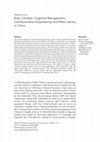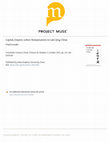Articles by Ulug Kuzuoglu

Modern Chinese Literature and Culture, 2022
This article explores the transnational history of the science behind the mass literacy movement ... more This article explores the transnational history of the science behind the mass literacy movement in China in the 1920s and 1930s. In particular, it investigates the reformers' attempts to reduce the number of Chinese characters to a "basic" set of around one thousand in an effort to promote mass literacy. In contrast to earlier literature that examined the history of mass literacy within the context of nation-building and citizenship, this article approaches the issue as a product of communication engineering and information management. It demonstrates that the effort to reduce the number of characters was deeply tied to the birth of behavioral psychology and statistical sciences in China as well as Euro-American theories of language and communication. Many of the leading Chinese figures in mass literacy campaigns were well informed by the methods of American behavioral sciences, which they employed to reduce the number of Chinese characters and optimize the learning process. This effort to invent a basic Chinese, however, gave birth to a critical question: which characters, after all, were "essential" for communication? The Chinese reformers' search for information efficiency quickly turned into an ideological inquiry into the politics of language and writing in a modernizing China.

Journal of Asian Studies, 2022
This article rethinks the history of Chinese script reforms and proposes a new genealogy for the ... more This article rethinks the history of Chinese script reforms and proposes a new genealogy for the Chinese Latin Alphabet (CLA), invented in 1931 by Chinese and Russian revolutionaries in the Soviet Union. Situating script reforms within a global information age that emerged out of the nineteenth-century communications revolution, the article historicizes the CLA within a technologically and ideologically contrived Sino-Soviet space. In particular, it shows the intimate links between the CLA and the Unified New Turkic Alphabet (UNTA), which grew out of a latinization movement based in Baku, Azerbaijan. The primary purpose of the UNTA was to latinize the Arabic script of the Turkic people living in Soviet Central Asia, but it was immediately exported to the non-Turkic world as well in an effort to latinize languages across Eurasia and ignite revolutionary internationalism. This article investigates the forgotten figures involved in carrying the Latin alphabet from Baku to Shanghai and offers a new framework to scrutinize the history of language, scripts, and knowledge production across Eurasia.

Twentieth-Century China , 2021
This article explores the history of the Roman alphabet in the late Qing empire (1637–1912). Foll... more This article explores the history of the Roman alphabet in the late Qing empire (1637–1912). Following the opening of treaty ports to Western capital in the mid-nineteenth century, missionaries and diplomats who entered the Qing territories began to romanize various local languages. By the end of the nineteenth century, more than 20 languages had been romanized, which had an indelible impact on the politics of language and writing in China in the following decades. This article examines the
origins of romanization in nineteenth-century China by situating it within a larger history of capitalism, imperialism, and the industrial printing press. Exploring the ideological and material dimensions of alphabetization, it contends that the Roman alphabet imposed a new epistemology of writing on China, which generated novel contradictions regarding language politics––contradictions that are still extant today.

International Journal of Middle East Studies, 2020
This paper explores the history of the alphabet revolutions in the Ottoman Empire and the Russian... more This paper explores the history of the alphabet revolutions in the Ottoman Empire and the Russian Empire, beginning in the 1860s and culminating with the new Turkish alphabet and the Soviet latinization movement in the 1920s. Unlike earlier works that have treated these movements separately, this article traces the origins of the alphabet revolutions to the 19th-century communications revolution, when the telegraph and movable metal type challenged the existing modes of knowledge production and imposed new epistemologies of writing on the Muslims in the Russo-Ottoman space. This article examines the media technologies of the era and the cross-imperial debates surrounding various alphabet proposals that predated latinization and suggests that the history of language reform in the Russo-Ottoman world be reevaluated as a product of a modernizing information age that eventually changed the entire linguistic landscape of Eurasia.

Information & Culture, 2018
Faster access to information was an overwhelming concern for Chinese reformists during the Republ... more Faster access to information was an overwhelming concern for Chinese reformists during the Republican era (1912-1949). They claimed that the nonalphabetical nature of Chinese characters presented obstacles to indexing, a fundamental technology for efficient information access and retrieval. In a matter of three decades, nearly one hundred new indices were invented for Chinese characters. Competition over which indices would prevail was fierce, especially among dictionary publishers, which stood to benefit greatly in the nascent Chinese dictionary market. This article follows the two main publishing houses in China, Commercial Press and Zhonghua Press, that invented indices in order to dominate the market from the founding of the republic in 1912 to the start of the war against Japan in 1937. As dozens of inventors of indices made clear, however, indexing technologies were situated within a larger social context, and the invention and destruction of indices were sites of political and financial contestation.
Cryptologia, 2018
This paper is the first scholarly attempt to examine the history of Chinese cryptography and the ... more This paper is the first scholarly attempt to examine the history of Chinese cryptography and the role it played in building the intelligence network of the Chinese Nationalist Party (KMT) from 1927 to 1949. Rather than investigating the institutional structure of intelligence, I focus on Chinese characters, the primary medium that made cryptology and intelligence possible. Given that the Chinese writing system is by nature nonalphabetic and thus noncipherable, how did cryptography work in Chinese? How did the state and its scientists reengineer Chinese characters for the purposes of secret communication? This paper argues that due to the Chinese writing system itself, Chinese cryptography was bound to the use of codebooks rather than ciphers; thus, “codebook management” was central to building intelligence networks in China.
Essays by Ulug Kuzuoglu
A historical look into the naming of streets in Taipei. (In Turkish)
This essay charts a history of the word "brainwashing," arguing that the origins of the term are ... more This essay charts a history of the word "brainwashing," arguing that the origins of the term are to be found in the KMT's New Life Movement in the 1930s. (In Turkish)
A philological and historical genealogy of "Dihua Street" in Taipei. (In Turkish)
Book Reviews by Ulug Kuzuoglu

The China Quarterly, 2024
usually a strength, but there are moments when one wishes for a more critical attitude. Robert, p... more usually a strength, but there are moments when one wishes for a more critical attitude. Robert, perhaps, takes the glowing accounts of evangelical success he draws on too much at face value. It doesn't matter whether George Harris really won all the street-corner religious debates he provoked. However, Robert's consideration of the posters as tools of persuasion would only be enhanced by a consideration of missionary accounts of preaching with posters as another kind of persuasive tool, in this instance directed at audiences outside of China, upon whose donations the CIM in part depended. More seriously, it would be valuable for scholars with this sympathy and expertise to openly engage with scholarship that is sceptical about missionary contributions. The most relevant work here might be Larissa N. Heinrich's book The Afterlife of Images: Translating the Pathological Body between China and the West (Duke University Press, 2008), which argues that missionaries helped generate and perpetuate the damaging stereotype of China as the "sick man of Asia." Taken as a whole, however, this lively, thoughtfully designed volume is a rich contribution to our understanding of Chinese culture in the early 20th century, with each chapter supplying fresh insights and information. It is suited for use in courses on a range of topics, from religion to propaganda, to Chinese history, art history and visual culture, and the transcultural exchange of ideas and images. Its value for teaching is enhanced, as mentioned above, by the Chinese Christian Posters website, which can support a variety of student projects, as well as more advanced research.
Papers by Ulug Kuzuoglu

Modern Chinese Literature and Culture
This article explores the transnational history of the science behind the mass literacy movement ... more This article explores the transnational history of the science behind the mass literacy movement in China in the 1920s and 1930s. In particular, it investigates the reformers’ attempts to reduce the number of Chinese characters to a “basic” set of around one thousand in an effort to promote mass literacy. In contrast to earlier literature that examined the history of mass literacy within the context of nation-building and citizenship, this article approaches the issue as a product of communication engineering and information management. It demonstrates that the effort to reduce the number of characters was deeply tied to the birth of behavioral psychology and statistical sciences in China as well as Euro-American theories of language and communication. Many of the leading Chinese figures in mass literacy campaigns were well informed by the methods of American behavioral sciences, which they employed to reduce the number of Chinese characters and optimize the learning process. This e...

The Journal of Asian Studies, 2022
This article rethinks the history of Chinese script reforms and proposes a new genealogy for the ... more This article rethinks the history of Chinese script reforms and proposes a new genealogy for the Chinese Latin Alphabet (CLA), invented in 1931 by Chinese and Russian revolutionaries in the Soviet Union. Situating script reforms within a global information age that emerged out of the nineteenth-century communications revolution, the article historicizes the CLA within a technologically and ideologically contrived Sino-Soviet space. In particular, it shows the intimate links between the CLA and the Unified New Turkic Alphabet (UNTA), which grew out of a latinization movement based in Baku, Azerbaijan. The primary purpose of the UNTA was to latinize the Arabic script of the Turkic people living in Soviet Central Asia, but it was immediately exported to the non-Turkic world as well in an effort to latinize languages across Eurasia and ignite revolutionary internationalism. This article investigates the forgotten figures involved in carrying the Latin alphabet from Baku to Shanghai and ...

This dissertation explores the global history of Chinese script reforms-the effort to phoneticize... more This dissertation explores the global history of Chinese script reforms-the effort to phoneticize Chinese language and/or simplify the writing system-from its inception in the 1890s to its demise in the 1980s. These reforms took place at the intersection of industrialization, colonialism, and new information technologies, such as alphabet-based telegraphy and breakthroughs in printing technologies. As these social and technological transformations put unprecedented pressure on knowledge management and the use of mental and clerical labor, many Chinese intellectuals claimed that learning Chinese characters consumed too much time and mental energy. Chinese script reforms, this dissertation argues, were an effort to increase speed in producing, transmitting, and accessing information, and thus meet the demands of the industrializing knowledge economy. The industrializing knowledge economy that this dissertation explores was built on and sustained by a psychological understanding of the human subject as a knowledge machine, and it was part of a global moment in which the optimization of labor in knowledge production was a key concern for all modernizing economies. While Chinese intellectuals were inventing new signs of inscription, American behavioral psychologists, Soviet psycho-economists, and Central Asian and Ottoman technicians were all experimenting with new scripts in order to increase mental efficiency and productivity. This dissertation reveals the intimate connections between the Chinese and non-Chinese script engineering projects that were taking place synchronically across the world. The chapters of this work demonstrate for the first time, for instance, that the Table of Contents List of Illustrations ii Acknowledgements v Introduction
Cornell University Press, 2018
After Mao Zedong's Anti-Rightist Campaign of 1957–58, Chinese intellectuals were subjected to... more After Mao Zedong's Anti-Rightist Campaign of 1957–58, Chinese intellectuals were subjected to “re-education” by the state. This book draws on labor farm archives, interviews, and memoirs to provide a remarkable look at the suffering and complex psychological world of these banished Beijing intellectuals. The book's use of newly uncovered Chinese-language sources challenges the concept of the intellectual as renegade martyr, showing how exiles often declared allegiance to the state for self-preservation. While Mao's campaign victimized the banished, many of those same people also turned against their comrades. The book describes the ways in which the state sought to remold the intellectuals, and it illuminates the strategies the exiles used to deal with camp officials and improve their chances of survival.
Cryptologia, 2018
This paper is the first scholarly attempt to examine the history of Chinese cryptography and the ... more This paper is the first scholarly attempt to examine the history of Chinese cryptography and the role it played in building the intelligence network of the Chinese Nationalist Party (KMT) from 1927 to 1949. Rather than investigating the institutional structure of intelligence, I focus on Chinese characters, the primary medium that made cryptology and intelligence possible. Given that the Chinese writing system is by nature nonalphabetic and thus noncipherable, how did cryptography work in Chinese? How did the state and its scientists reengineer Chinese characters for the purposes of secret communication? This paper argues that due to the Chinese writing system itself, Chinese cryptography was bound to the use of codebooks rather than ciphers; thus, "codebook management" was central to building intelligence networks in China.

Information & Culture, 2018
Abstract:Faster access to information was an overwhelming concern for Chinese reformists during t... more Abstract:Faster access to information was an overwhelming concern for Chinese reformists during the Republican era (1912–1949). They claimed that the nonalphabetical nature of Chinese characters presented obstacles to indexing, a fundamental technology for efficient information access and retrieval. In a matter of three decades, nearly one hundred new indices were invented for Chinese characters. Competition over which indices would prevail was fierce, especially among dictionary publishers, which stood to benefit greatly in the nascent Chinese dictionary market. This article follows the two main publishing houses in China, Commercial Press and Zhonghua Press, that invented indices in order to dominate the market from the founding of the republic in 1912 to the start of the war against Japan in 1937. As dozens of inventors of indices made clear, however, indexing technologies were situated within a larger social context, and the invention and destruction of indices were sites of political and financial contestation.
Literary Information in China, 2020











Uploads
Articles by Ulug Kuzuoglu
origins of romanization in nineteenth-century China by situating it within a larger history of capitalism, imperialism, and the industrial printing press. Exploring the ideological and material dimensions of alphabetization, it contends that the Roman alphabet imposed a new epistemology of writing on China, which generated novel contradictions regarding language politics––contradictions that are still extant today.
Essays by Ulug Kuzuoglu
Book Reviews by Ulug Kuzuoglu
Papers by Ulug Kuzuoglu
origins of romanization in nineteenth-century China by situating it within a larger history of capitalism, imperialism, and the industrial printing press. Exploring the ideological and material dimensions of alphabetization, it contends that the Roman alphabet imposed a new epistemology of writing on China, which generated novel contradictions regarding language politics––contradictions that are still extant today.
Codes of Modernity explores the global history of Chinese script reforms—efforts to alphabetize or simplify the writing system—from the 1890s to the 1980s. Examining the material conditions and political economy underlying attempts to modernize scripts, Uluğ Kuzuoğlu argues that these reforms were at the forefront of an emergent information age. Faced with new communications technologies and infrastructures as well as industrial, educational, and bureaucratic pressures for information management, reformers engineered scripts as tools to increase labor efficiency and create alternate political futures.
Kuzuoğlu considers dozens of proposed scripts, including phonetic alphabets, syllabaries, character simplification schemes, latinization, and pinyin. Situating them in a transnational framework, he stretches the geographical boundaries of Chinese script reforms to include American behavioral psychologists, Soviet revolutionaries, and Central Asian typographers, who were all devising new scripts in pursuit of informational efficiency. Codes of Modernity brings these experiments together to offer new ways to understand scripts and rethink the shared experiences of a global information age.